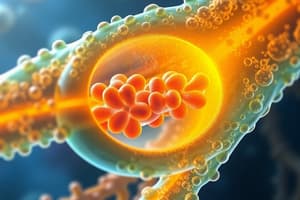Podcast
Questions and Answers
What is the primary function of NOD26 as mentioned in the text?
What is the primary function of NOD26 as mentioned in the text?
- Enhancing cell metabolism
- Facilitating ion transport
- Serving as a water channel (correct)
- Regulating protein synthesis
Why are membrane contact sites (MCS) important in eukaryotic cells?
Why are membrane contact sites (MCS) important in eukaryotic cells?
- To facilitate vesicular transport
- To produce signaling lipids
- To initiate protein synthesis
- To regulate organelle homeostasis (correct)
Which type of transporter is involved in maintaining Ca2+ homeostasis?
Which type of transporter is involved in maintaining Ca2+ homeostasis?
- Amino acid transporter
- Ca2+ transporter (correct)
- H+-PPase
- Chloride channel
What is the role of transport membrane condensers (TMC) in industrial processes?
What is the role of transport membrane condensers (TMC) in industrial processes?
What can mutations or alterations in phosphoinositide metabolizing enzymes lead to?
What can mutations or alterations in phosphoinositide metabolizing enzymes lead to?
Why are H+ transporters like H+-ATPases important in cells?
Why are H+ transporters like H+-ATPases important in cells?
What is the main function of transport membranes in biological systems?
What is the main function of transport membranes in biological systems?
What is the product of nitrogenase in bacteroids in nitrogen-fixing nodules?
What is the product of nitrogenase in bacteroids in nitrogen-fixing nodules?
Which protein is responsible for transporting water across the symbiosome membrane in plant-microbe interactions?
Which protein is responsible for transporting water across the symbiosome membrane in plant-microbe interactions?
What is the primary role of H+-ATPase in the transport process across the symbiosome membrane?
What is the primary role of H+-ATPase in the transport process across the symbiosome membrane?
Which ion is transported by the voltage-gated monovalent cation channel across the symbiosome membrane?
Which ion is transported by the voltage-gated monovalent cation channel across the symbiosome membrane?
Why is Nodulin 26 (NOD26) widely used as a marker for the symbiosome membrane?
Why is Nodulin 26 (NOD26) widely used as a marker for the symbiosome membrane?
Flashcards are hidden until you start studying
Study Notes
Transport Membrane
Transport membranes are essential components of biological systems that facilitate the movement of various substances across cellular membranes. They are part of the symbiosome membrane (SM) in plant-microbe interactions, specifically in nitrogen-fixing nodules formed by rhizobia bacteria in the roots of legumes. The transport processes in these membranes are complex and involve multiple proteins, transporters, and channels that regulate the movement of ions, molecules, and nutrients.
Nitrogen Transport
In nitrogen-fixing nodules, the product of nitrogenase in bacteroids is ammonia, which is thought to diffuse out of the bacteroids into the acidic SM, where much of it is protonated to ammonium. The SM is energized by an H+-ATPase that pumps H+ into the SM, establishing a concentration gradient that promotes the efflux of NH3/NH4+ into the plant cytosol, where it is rapidly assimilated. Two avenues have been identified for the transport of NH3/NH4+ across the SM: a channel for facilitated diffusion of ammonia, and a voltage-gated monovalent cation channel that transports NH4+ as well as potassium and sodium ions.
Transport Membrane Proteins
Nodulin 26 (NOD26), an aquaporin that transports water, is the likely candidate for passage of NH3 across the SM. It is estimated to constitute 10% of the protein content of the SM, is exclusively localized to the SM, and due to its prevalence is widely used as a marker for the membrane. NOD26 functions as a multifunctional aquaglyceroporin, serving as a water channel and facilitating the passage of other small, uncharged molecules.
Phosphoinositide Transport and Metabolism
Phosphoinositide lipid transport and metabolism are critical for the regulation of membrane contact sites (MCS) in eukaryotic cells. These MCS are non-vesicular lipid transport portals that engage in extensive communication to influence organelle homeostasis, and are important for phosphoinositide metabolism and regulation. Phosphoinositides are a family of signaling lipids that play a profound role in regulating protein function at the membrane. Mutations or alterations in phosphoinositide metabolizing enzymes can lead to various developmental, neurodegenerative, and metabolic disorders.
Membrane Transporters
Membrane transporters are involved in the transport of various molecules across cellular membranes. They are divided into different types, such as ion transporters, sugar transporters, amino acid transporters, and others, and are essential for maintaining ion homeostasis and improving plant tolerance under abiotic stress. H+ transporters, such as H+-ATPases and H+-PPases, are involved in the transport of H+ in cells and play a crucial role in maintaining ion homeostasis. Anion transporters, such as slow anion channels (SLAC/SLAH) and chloride channels (CLC), regulate the distribution of anions inside and outside the cell. Ca2+ transporters are essential for maintaining Ca2+ homeostasis and maintaining cell membrane integrity.
Transport Membrane Condenser Heat Exchangers
Transport membrane condensers (TMC) are used in various applications, such as membrane-based flue gas dehydration and breaking the water-energy nexus. They are designed to improve heat transfer efficiency and are used in power plants and other industrial processes. TMC materials can be inorganic or polymeric, and their thermal conductivity and water dehydration performance need to be optimized for specific applications.
In conclusion, transport membranes play a crucial role in various biological and industrial processes, facilitating the movement of substances across cellular and synthetic membranes. They are essential for maintaining ion homeostasis, regulating phosphoinositide metabolism, and improving the efficiency of various industrial processes.
Studying That Suits You
Use AI to generate personalized quizzes and flashcards to suit your learning preferences.




